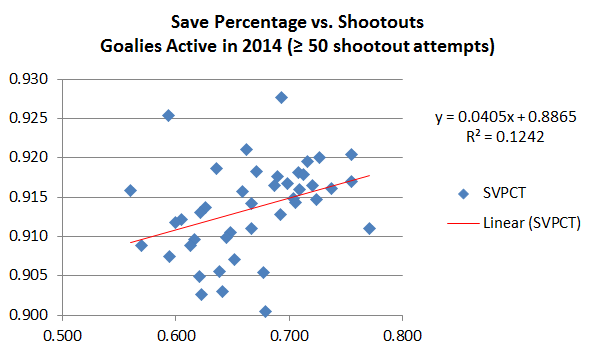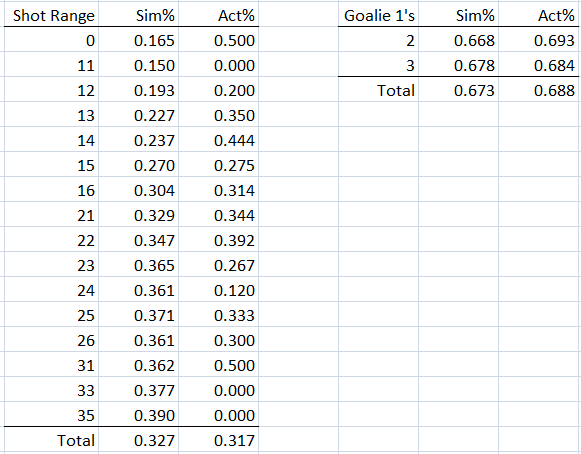I am an avid player of the APBA hockey game but I only play tournaments. Since I need to play playoff-style overtimes, I never had to deal with the shootout. However, when I got the 2014 Olympic set, I would have to use the shootout, because that’s what the Olympics did. Even though my Olympic replay was going to tweak the seedings a bit by using the 1980 system rather than the 2014 system, I’m still keeping the 2014 game rules.
So in my first game, Switzerland pushed Russia to a shootout. So I reviewed the rules:
- Get the shot range for the shooter
- Add 10 (a.k.a 6) to the shot range, and use either this number or 43, whichever is lower
- Roll the dice for the shot
- If the shot roll is within range, roll for the goalie. If you roll a 1 for the goalie, it is not a goal, otherwise, it is a goal
- If the shot roll is outside of range, it is not a goal
Rather anti-climatic, despite the Swiss winning the shootout 3-2. And frankly, I’m a bit worried about the realism. Recent stat geekery has shown that shot percentages tend to be very volatile, and not a great reflection of offensive ability. So, me being me, I had to run a few tests. First I had to see what the current out-of-the box rules produce. A while back I had entered in all of the cards from the 2010-11 season for the Western Conference into Excel, so I do have a base to test things. I gave each player that had a card the same number of shootout attempts he had in the real life season, with the goalie picked at random. This goalie picking was weighted by minutes played, so the more active goalies had a better chance of being picked. After running 100 trials, I got these numbers: 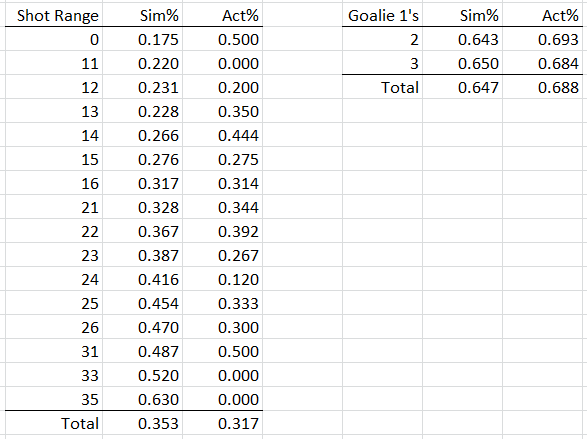 Note that since this test was with only carded Western Conference players, the shooting percentage and the save percentage do not match up. The simulation also proved to be a little high, and you had to wonder if the goalie difference is right. Just two different versions of goalies (2 1’s or 3 1’s) don’t seem fine enough. So I had to see what differentiates the shootout in real life. You’ll notice at first glance that it doesn’t seem that there’s a great correlation between shooting percentage and shootout percentage. So first let’s see if there’s any correlation:
Note that since this test was with only carded Western Conference players, the shooting percentage and the save percentage do not match up. The simulation also proved to be a little high, and you had to wonder if the goalie difference is right. Just two different versions of goalies (2 1’s or 3 1’s) don’t seem fine enough. So I had to see what differentiates the shootout in real life. You’ll notice at first glance that it doesn’t seem that there’s a great correlation between shooting percentage and shootout percentage. So first let’s see if there’s any correlation: 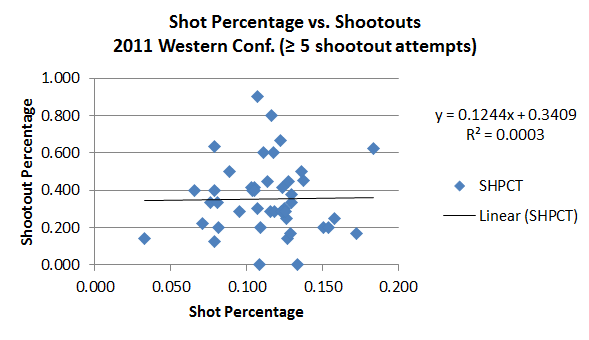 Pretty much no correlation. But only one conference and one season is going to be a small sample size. Because the stats were (relatively) easy to get, I decided to go with active players with at least 25 career shootout attempts. The particular player’s shot percentage reflects only their stats in the shootout era (2005-present).
Pretty much no correlation. But only one conference and one season is going to be a small sample size. Because the stats were (relatively) easy to get, I decided to go with active players with at least 25 career shootout attempts. The particular player’s shot percentage reflects only their stats in the shootout era (2005-present). 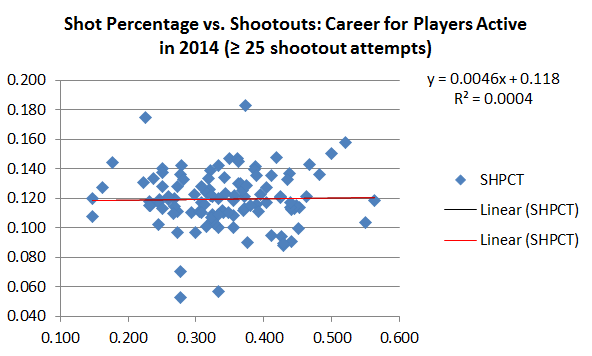 It’s pretty obvious that using shooting percentage is not the way to go, since there seems to be little correlation. Another idea to try would be shots per minutes played. This is the current hot stat du jour for the hockey analyst crowd, and since we’re only looking for an offensive measure, we have it. First, the 2011 Western Conference:
It’s pretty obvious that using shooting percentage is not the way to go, since there seems to be little correlation. Another idea to try would be shots per minutes played. This is the current hot stat du jour for the hockey analyst crowd, and since we’re only looking for an offensive measure, we have it. First, the 2011 Western Conference: 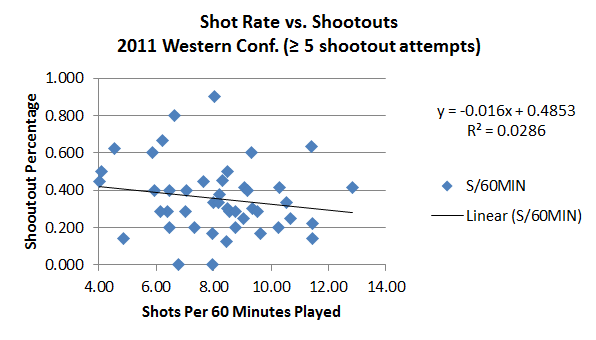 Oh my, a negative correlation. That isn’t good. Again, maybe just small sample size. Let’s check the careers:
Oh my, a negative correlation. That isn’t good. Again, maybe just small sample size. Let’s check the careers: 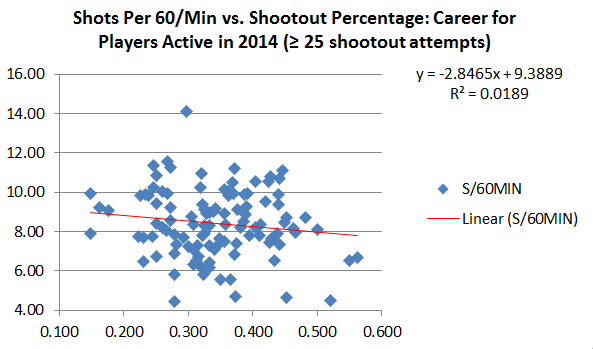 Ack, negative correlation again. This isn’t going to be of much help at all, and there really aren’t any other card tricks we can do to help out. So let’s set this aside for a minute and go to the goalies. We saw that the goalies in 2011 all had either two 1’s or three 1’s on their card. And in other seasons, only the fringiest of the fringe goalies will have less than two or more than four. So we pretty much have two classes of goalies: good and bad. First take a look at 2011:
Ack, negative correlation again. This isn’t going to be of much help at all, and there really aren’t any other card tricks we can do to help out. So let’s set this aside for a minute and go to the goalies. We saw that the goalies in 2011 all had either two 1’s or three 1’s on their card. And in other seasons, only the fringiest of the fringe goalies will have less than two or more than four. So we pretty much have two classes of goalies: good and bad. First take a look at 2011: 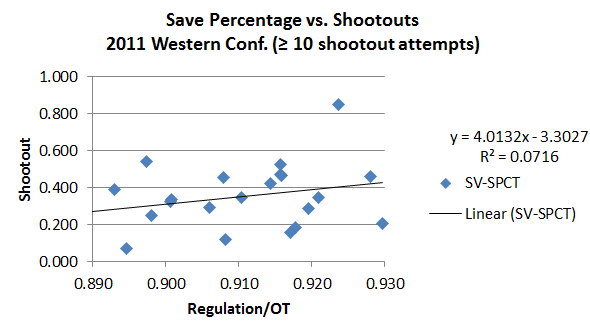 Hey, looky there, a bit of a trend line. And likely just enough to show a bit of variation between the bad goalies and the good goalies. Let’s just make sure this isn’t a one time thing:
Hey, looky there, a bit of a trend line. And likely just enough to show a bit of variation between the bad goalies and the good goalies. Let’s just make sure this isn’t a one time thing:
Even more correlation when we go career, so even though it’s not a large correlation, it is something. In this group, the goalie straddling the 25% percentile was at a .911 save percentage and the 75% percentile was at .918, a .007 difference. The difference between high (.928) and low (.900) was .028. The goalie card comes into play about half the time, so you should be aiming for a 1/72 difference between two and three 1’s. That translates to .014. That’s a little large for the percentile difference, but too small for the high/low difference. So we’ll call it good enough — the 1’s rule stays.
However, there was one unintended quirk I found that can be used to facilitate shootouts: a home-road split. The NHL often publishes some of the team stats in home-road splits, and shootouts is one of them. Surprisingly, the road team has the advantage – .338 vs .319 in shot percentage and .524 vs. .476 in winning percentage – since the inception of the shootout. A .019 difference, it’s enough to give the road team a one point advantage when checking the shot range.
So, if you’ve made it this far, congratulations. After thinking it over, I decided I would need some sort of differentiation between the skaters, and it looks like the lesser of two evils is the shot percentage. One thing I did however was to lessen the ceiling used for the shot range, so the players who had a lucky season shooting won’t be overused. Here are the rules I now use for the shootout now, with changes in bold:
- Get the shot range for the shooter
- Add 5 if the home team or 10 (aka 6) if the road team to the shot range, and use either this number or 33, whichever is lower (if this is a “neutral” site game, use 10/6)
- Roll the dice for the shot
- If the shot roll is within range, roll for the goalie. If you roll a 1 for the goalie, it is not a goal, otherwise, it is a goal
- If the shot roll is outside of range, it is not a goal
The numbers by this method were much more realistic:
The road split was .335 vs .318.
So all of this work just to make a minor change. And it’s still going to be pretty anti-climatic. But at least I now know that there really isn’t a better way to do it without the cards having actual shootout stats.
